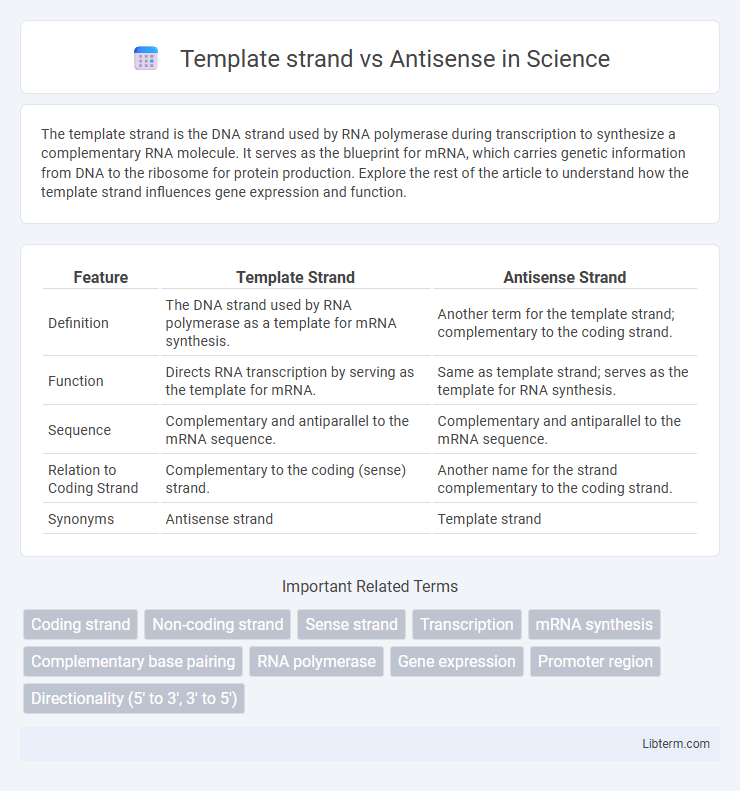The template strand is the DNA strand used by RNA polymerase during transcription to synthesize a complementary RNA molecule. It serves as the blueprint for mRNA, which carries genetic information from DNA to the ribosome for protein production. Explore the rest of the article to understand how the template strand influences gene expression and function.
Table of Comparison
| Feature | Template Strand | Antisense Strand |
|---|---|---|
| Definition | The DNA strand used by RNA polymerase as a template for mRNA synthesis. | Another term for the template strand; complementary to the coding strand. |
| Function | Directs RNA transcription by serving as the template for mRNA. | Same as template strand; serves as the template for RNA synthesis. |
| Sequence | Complementary and antiparallel to the mRNA sequence. | Complementary and antiparallel to the mRNA sequence. |
| Relation to Coding Strand | Complementary to the coding (sense) strand. | Another name for the strand complementary to the coding strand. |
| Synonyms | Antisense strand | Template strand |
Introduction to DNA Strands
The template strand in DNA serves as the guide for RNA synthesis during transcription, ensuring accurate complementary base pairing with the newly formed mRNA. The antisense strand, often synonymous with the template strand, is read in the 3' to 5' direction to produce an mRNA sequence identical to the sense strand except for uracil replacing thymine. Understanding the distinction between the template (antisense) and coding (sense) strands is essential for insights into gene expression and molecular biology processes.
Defining the Template Strand
The template strand, also known as the antisense strand, serves as the DNA strand used by RNA polymerase to synthesize a complementary RNA molecule during transcription. It is oriented in the 3' to 5' direction, enabling the RNA to be built 5' to 3', ensuring accurate gene expression. Distinguishing the template strand from the coding (sense) strand is essential for understanding transcriptional directionality and gene regulation mechanisms.
What is the Antisense Strand?
The antisense strand, also known as the template strand, serves as the blueprint for RNA synthesis during transcription by providing the complementary sequence used to create messenger RNA (mRNA). It runs in the 3' to 5' direction, enabling RNA polymerase to assemble mRNA in the 5' to 3' direction. This strand is critical in gene expression because it determines the exact nucleotide sequence of the mRNA that ultimately guides protein synthesis.
Template Strand vs Antisense Strand: Key Differences
The template strand, also known as the antisense strand, serves as the DNA strand used by RNA polymerase to synthesize a complementary RNA molecule during transcription. The key difference lies in terminology: the template strand is functionally defined by its role in RNA synthesis, while the antisense strand refers to its sequence being complementary to the mRNA sequence. Both terms describe the same DNA strand responsible for guiding mRNA formation, distinguishing it from the coding or sense strand whose sequence matches the RNA transcript.
Role of Template Strand in Transcription
The template strand, also known as the antisense strand, serves as the crucial DNA sequence used by RNA polymerase to synthesize a complementary RNA transcript during transcription. This strand contains the antisense code that directly guides the assembly of ribonucleotides into a messenger RNA (mRNA) molecule, ensuring accurate gene expression. The non-template or sense strand matches the mRNA sequence, but only the template strand acts as the direct genetic blueprint for RNA synthesis.
Function of Antisense Strand in Gene Expression
The antisense strand serves as the template for RNA synthesis during transcription, providing the complementary sequence to the mRNA. It directs the RNA polymerase to accurately transcribe the coding information needed for protein synthesis. By controlling which genes are transcribed, the antisense strand plays a crucial role in regulating gene expression.
Template vs Antisense: Nomenclature Confusion
The terms "template strand" and "antisense strand" are often used interchangeably, but they can cause nomenclature confusion in molecular biology. The template strand refers to the DNA strand read by RNA polymerase to synthesize a complementary RNA molecule, whereas the antisense strand is defined relative to the RNA sequence and may not always correspond to the template strand in certain contexts. Clear differentiation is crucial in genetic transcription studies to avoid misinterpretation of strand function and directionality.
Biological Examples of Each Strand
The template strand, also known as the antisense strand, serves as the DNA sequence that RNA polymerase reads to synthesize complementary mRNA, as seen in the expression of the lac operon in E. coli where the antisense strand guides transcription of b-galactosidase genes. In contrast, the coding strand, or sense strand, has the same sequence as the mRNA except for thymine replaced with uracil and is exemplified in human hemoglobin genes where the coding strand sequence directly corresponds to the amino acid sequence of the protein. These distinctions play critical roles in gene expression regulation in organisms ranging from bacteria to humans.
Importance in Genetic Engineering
The template strand, also known as the antisense strand, plays a crucial role in genetic engineering as it serves as the DNA sequence copied into RNA during transcription, ensuring accurate gene expression in recombinant DNA technology. Understanding and manipulating the antisense strand enables precise design of antisense oligonucleotides for gene silencing or knockdown experiments, essential in therapeutic gene regulation and functional genomics. Effective targeting of the template strand enhances CRISPR-Cas9 gene editing specificity by guiding RNA molecules to complementary DNA sequences, optimizing genome modification outcomes.
Summary and Future Perspectives
The template strand serves as the DNA sequence read by RNA polymerase to synthesize complementary RNA, while the antisense strand is often used interchangeably but specifically refers to the strand complementary to the mRNA. Advances in understanding the nuances between these strands enable improved gene editing and synthetic biology applications, particularly in designing antisense oligonucleotides for targeted gene regulation. Future research aims to enhance precision therapies by leveraging strand-specific interactions to modulate gene expression in disease contexts.
Template strand Infographic

 libterm.com
libterm.com